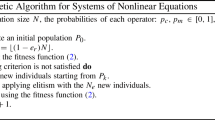Abstract
A parameter-less adaptive penalty scheme for steady-state genetic algorithms applied to constrained optimization problems is proposed. For each constraint, a penalty parameter is adaptively computed along the run according to information extracted from the current population such as the existence of feasible individuals and the level of violation of each constraint. Using real coding, rank-based selection, and operators available in the literature, very good results are obtained.
Access this chapter
Tax calculation will be finalised at checkout
Purchases are for personal use only
Preview
Unable to display preview. Download preview PDF.
Similar content being viewed by others
References
M. Schoenauer and Z. Michalewicz. Evolutionary computation at the edge of feasibility. In Parallel Problem Solving from Nature-PPSN IV, volume 1141, pages 245–254. Springer-Verlag, 1996. LNCS.
S. Koziel and Z. Michalewicz. Evolutionary algorithms, homomorphous mappings, and constrained parameter optimization. Evolutionary Computation, 7(1):19–44, 1999.
G.E. Liepins and W.D. Potter. A genetic algorithm approach to multiple-fault diagnosis. In Lawrence Davis, editor, Handbook of Genetic Algorithms, chapter 17, pages 237–250. Van Nostrand Reinhold, New York, New York, 1991.
D. Orvosh and L. Davis. Using a genetic algorithm to optimize problems with feasibility contraints. In Proc. of the First IEEE Conf. on Evolutionary Computation, pages 548–553, 1994.
H. Adeli and N-T. Cheng. Augmented lagrangian genetic algorithm for structural optimization. Journal of Aerospace Engineering, 7(1):104–118, January 1994.
H.J.C. Barbosa. A coevolutionary genetic algorithm for constrained optimization problems. In Proc. of the Congress on Evolutionary Computation, pages 1605–1611, Washington, DC, USA, 1999.
P.D. Surry and N.J. Radcliffe. The COMOGA method: Constrained optimisation by multiobjective genetic algorithms. Control and Cybernetics, 26(3), 1997.
T.P. Runarsson and X. Yao. Stochastic ranking for constrained evolutionary optimization. IEEE Trans. on Evolutionary Computation, 4(3):284–294, 2000.
A.H.C. van Kampen, C.S. Strom, and L.M.C. Buydens. Lethalization, penalty and repair functions for constraint handling in the genetic algorithm methodology. Chemometrics and Intelligent Laboratory Systems, 34:55–68, 1996.
Z. Michalewicz and M. Schoenauer. Evolutionary algorithms for constrained parameter optimization problems. Evolutionary Computation, 4(1):1–32, 1996.
R. Hinterding and Z. Michalewicz. Your brains and my beauty: Parent matching for constrained optimization. In Proc. of the Fifty Int. Conf. on Evolutionary Computation, pages 810–815, Alaska, May 4–9 1998.
S. Koziel and Z. Michalewicz. A decoder-based evolutionary algorithm for constrained optimization problems. In Proc. of the Fifth Parallel Problem Solving from Nature. Springer-Verlag, 1998. Lecture Notes in Computer Science.
J.-H. Kim and H. Myung. Evolutionary programming techniques for constrained optimization problems. IEEE Trans. on Evolutionary Computation, 2(1):129–140, 1997.
H.J.C. Barbosa and A.C.C. Lemonge. An adaptive penalty scheme in genetic algorithms for constrained optimization problems. In Proc. of the Genetic and Evolutionary Computation Conference, pages 287–294. Morgan Kaufmann Publishers, 2002.
S.E. Carlson and R. Shonkwiler. Annealing a genetic algorithm over constraints. In Proc. of the IEEE Int. Conf. on Systems, Man and Cybernetics, pages 3931–3936, 1998.
D. Powell and M.M. Skolnick. Using genetic algorithms in engineering design optimization with non-linear constraints. In Proc. of the Fifth Int. Conf. on Genetic Algorithms, pages 424–430. Morgan Kaufmann, 1993.
K. Deb. An efficient constraint handling method for genetic algorithms. Computer Methods in Applied Mechanics and Engineering, 186(2–4):311–338, June 2000.
Z. Michalewicz. A survey of constraint handling techniques in evolutionary computation. In Proc. of the 4th Int. Conf. on Evolutionary Programming, pages 135–155, Cambridge, MA, 1995. MIT Press.
Z. Michalewicz, D. Dasgupta, R.G. Le Riche, and M. Schoenauer. Evolutionary algorithms for constrained engineering problems. Computers & Industrial Engineering Journal, 30(2):851–870, 1996.
R.G. Le Riche, C. Knopf-Lenoir, and R.T. Haftka. A segregated genetic algorithm for constrained structural optimization. In Proc. of the Sixth Int. Conf. on Genetic Algorithms, pages 558–565, 1995.
H. Homaifar, S.H.-Y. Lai, and X. Qi. Constrained optimization via genetic algorithms. Simulation, 62(4):242–254, 1994.
J.A Joines and C.R. Houck. On the use of non-stationary penalty functions to solve nonlinear constrained optimization problems with GAs. In Proc. of the First IEEE Int. Conf. on Evolutionary Computation, pages 579–584, June 19–23 1994.
J.C. Bean and A.B. Alouane. A dual genetic algorithm for bounded integer programs. Dept. of Industrial and Operations Engineering, The University of Michigan, Tech. Rep. 92-53 1992.
D.W. Coit, A.E. Smith, and D.M. Tate. Adaptive penalty methods for genetic optimization of constrained combinatorial problems. INFORMS Journal on Computing, 6(2):173–182, 1996.
M. Schoenauer and S. Xanthakis. Constrained GA optimization. In Proc. of the Fifth Int. Conf. on Genetic Algorithms, pages 573–580. Morgan Kaufmann Publishers, 1993.
S. Ben Hamida and M. Schoenauer. ASCHEA: new results using adaptive segregational constraint handling. In Proc. of the 2002 Congress on Evolutionary Computation, volume 1, pages 884–889, May 2002.
J.A. Wright and R. Farmani. Genetic algorithms: A fitness formulation for constrained minimization. In GECCO 2001: Proc. of the Genetic and Evolutionary Computation Conference, pages 725–732. Morgan Kaufmann, 2001.
A.E. Eiben and J. I. van Hemert. Saw-ing EAs: adapting the fitness function for solving constrained problems. In D. Corne, M. Dorigo, and F. Glover, editors, New ideas in optimization, chapter 26, pages 389–402. McGraw-Hill, London, 1999.
Z. Michalewicz and D.B. Fogel. How to Solve It: Modern Heuristics. Springer-Verlag, 1999.
Z. Michalewicz. Genetic Algorithms + Data Structures = Evolution Programs. Springer-Verlag, New York, 1992.
H. Muhlenbein, M. Schomisch, and J. Born. The parallel genetic algorithm as function optimizer. Parallel Computing, 17(6–7):619–632, Sep 1991.
K. Deb and H.G. Beyer. Self-adaptive genetic algorithms with simulated binary crossover. Evolutionary Computation Journal, 9(2):197–221, 2001.
S.B. Hamida and M. Schoenauer. An adaptive algorithm for constrained optimization problems. In PPSN VI — LNCS, volume 1917, pages 529–538. Springer-Verlag, 2000.
Author information
Authors and Affiliations
Editor information
Editors and Affiliations
Rights and permissions
Copyright information
© 2003 Springer-Verlag Berlin Heidelberg
About this paper
Cite this paper
Barbosa, H.J.C., Lemonge, A.C.C. (2003). An Adaptive Penalty Scheme for Steady-State Genetic Algorithms. In: Cantú-Paz, E., et al. Genetic and Evolutionary Computation — GECCO 2003. GECCO 2003. Lecture Notes in Computer Science, vol 2723. Springer, Berlin, Heidelberg. https://doi.org/10.1007/3-540-45105-6_87
Download citation
DOI: https://doi.org/10.1007/3-540-45105-6_87
Published:
Publisher Name: Springer, Berlin, Heidelberg
Print ISBN: 978-3-540-40602-0
Online ISBN: 978-3-540-45105-1
eBook Packages: Springer Book Archive





